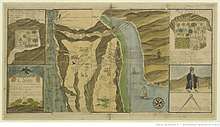Claude Sicard
Father Claude Sicard (1677–1726) was a French Jesuit priest, and an early modern visitor to Egypt, between 1708 and 1712, producing the earliest known map of the country.[1]

Sicard was a scholar and at the age of 22 was a professor in the seminary at Lyon.[2] He was well educated in Latin, Greek, Coptic and Arabic.[2] He was also skilled in cartography. His aim was to convert Egypt's Coptic Christians to Roman Catholicism.[2]
Sicard was Supervisor of the Jesuit Mission in Cairo. He ate only vegetables and conformed to the Egyptian way of living for nine successive years.[3]
He was the first European to locate Thebes. He identified the ruins of Karnak and Luxor as those of ancient Thebes.[4] Sicard commented that "Its remains are magnificent and more extensive than it is possible to imagine."[2]
Sicard died of plague from nursing the afflicted in 1726.[2]
References
- uwm.edu Archived 2007-01-22 at the Wayback Machine, Discovering Ancient Egypt
- Thompson, Jason. (2015). Wonderful Things: A History of Egyptology. 1: From Antiquity to 1881. American University of Cairo Press. pp. 77-78. ISBN 978-9774165993
- Roman Catholic Missions. (1832). The Quarterly Register 4: 216.
- La Farge, Henry Adams. (1980). Museums of Egypt. Newsweek. p. 165